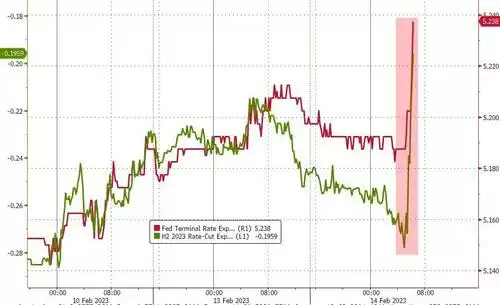“No Landing” v Hard or Soft Landing – No one really knows
News
|
Posted 15/02/2023
|
10426
Whilst debate rages as to whether the Fed can navigate a soft landing for the US economy (the goldilocks scenario of falling inflation, and an end to monetary tightening before a recession is triggered) versus the hard landing of tightening too far, too long and causing a recession; there’s a new scenario on Wall Street – “No Landing”. So what is this and what does it mean?
Bloomberg recently analogised inflation to the ‘alleged’ Chinese spy balloon. “It took a while to land and only did so because Washington shot it out of the sky”. Certainly not the soft landing or goldilocks scenario clearly favoured by markets at present with this risk on rally we have seen of late. Last night we saw the US CPI accelerate higher, not the lower Goldilocks scenario, up a 3 month high of 0.5% to an annualised 6.4%. Core inflation was also up 0.4%, higher than expected and marking the 32nd straight month of rises. Importantly too, despite the strong labour market, cost of living outstripped wage growth for the 22nd straight month.
The No Landing thesis, put forward by Apollo Management earlier this month sees the U.S. economy not slowing down to the extent many expect. Inflation dips a bit but remains above-trend and certainly above the Fed’s comfort level and target of 2%, a far cry from last night’s 6.4%. That means the Fed is forced to not only hike rates by more than expected, but keep them elevated for longer. Certainly not what either soft or hard landing proponents expect. That means hard times ahead for risk assets and, according to Apollo it brings back:
“volatile market action we saw in 2022 because it reintroduces uncertainty about inflation and about the Fed,”
This all of course was bolstered by that blowout January NFP jobs print we discussed here that momentarily had the market second guessing if hikes were soon to stop and the mythical pivot was close. Last night’s CPI print adds further weight to the prospect of higher terminal rates and below clearly depicts that reaction with terminal rate expectations moving up to 5.238% and chances of a rate cut in the second half of the years dropping.

A nuance of the No Landing stance is the scenario where the economy enters a recession whilst inflation hasn’t truly washed out and central banks and governments ignite the easy money policy and fiscal spending flame-thrower either in real terms or the jawboning we discussed Monday. That of course then sees inflation take off again without a fundamentally strong economy and off we go again into stagflationary territory again and the sort of volatility Apollo predict.
In many ways though, the No Landing scenario feels a bit like the Soft Landing, but the key difference is the stickier and indeed resurgent inflation outcome whilst they are adding even more debt to the pile that then needs servicing at the inevitable higher rates.
Wall Street was relatively flat at the end of a choppy session on the CPI print last night. The USD too rose only mildly, and gold ended flat. In other words, the print wasn’t enough to upset this risk-on dollar-off trend we have seen now for a couple of months. Soft landing sentiment prevails. The re-entering of China into the market, it printing $1trillion of new money in January (!), and general liquidity provisions being implemented by other central banks around the world (but predominantly outside of the west) marks a definite shift in the removal of global liquidity that has spanked financial markets this last year.
Of course generalisations like Hard, Soft and even No Landings are filled with sub scenarios and forces that, to be honest, not one ‘expert’ can predict until they claim so after the fact. Warren Buffett famously once said: “Forecasts may tell you a great deal about the forecaster; they tell you nothing about the future.”
We remain in an economic cocktail of record high debt, rising interest rates, moribund economic growth, negative real interest rates, multi decade high geopolitical and reserve currency tensions, at the foot of the biggest technology and societal disruption since the internet in AI, and a generational change in demographics. Forecasts must be viewed within that context and portfolios concentrate on having a balance of truly uncorrelated assets. It is widely reported that there are record amounts of cash sitting on the sideline at the moment. The market moves, whilst looking constructive for risk-on, are off meagre volumes. We are reminded of yet another Buffett quote:
“Today people who hold cash equivalents feel comfortable. They shouldn’t. They have opted for a terrible long-term asset, one that pays virtually nothing and is certain to depreciate in value.”
At Ainslie we are seeing 2 big trends of late. High net worth people getting their money out of banks and into gold (a combination of Buffett’s view and Bail In risk), and people selling property and paying us direct from settlement trust accounts, diversifying out of property-heavy portfolios.
Topically, our trademark says, “Balance your wealth in an unbalanced world”….